Related Research Articles

Public housing, also known as social housing or subsidized housing, is a form of housing tenure in which the property is usually owned by a government authority, either central or local.

In Ireland and the United Kingdom, housing associations are private, non-profit making organisations that provide low-cost "social housing" for people in need of a home. Any budget surplus is used to maintain existing housing and to help finance new homes and it cannot be used for personal benefit of directors or shareholders. Although independent, they are regulated by the state and commonly receive public funding. They are now the United Kingdom's major providers of new housing for rent, while many also run shared ownership schemes to help those who cannot afford to buy a home outright.

Clapham Park is an area in the Borough of Lambeth in London, to the south of central Clapham and west of Brixton.

Chiltern District was one of four local government districts of Buckinghamshire in south central England from 1974 to 2020. It was named after the Chiltern Hills on which the region sits.

A housing cooperative, or housing co-op, is a legal entity, usually a cooperative or a corporation, which owns real estate, consisting of one or more residential buildings; it is one type of housing tenure. Housing cooperatives are a distinctive form of home ownership that have many characteristics that differ from other residential arrangements such as single family home ownership, condominiums and renting.
Housing Benefit is a means tested social security benefit in the United Kingdom that is intended to help meet housing costs for rented accommodation. It is the second biggest item in the Department for Work and Pensions' budget after the state pension, totalling £23.8 billion in 2013–14.

Affordable housing is housing which is deemed affordable to those with a household income at or below the median as rated by the national government or a local government by a recognized housing affordability index. Most of the literature on affordable housing refers to mortgages and a number of forms that exist along a continuum – from emergency homeless shelters, to transitional housing, to non-market rental, to formal and informal rental, indigenous housing, and ending with affordable home ownership.

Poplar HARCA is a housing association in the East End of London, England. It is the landlord of about 9,000 homes in the East London area, a quarter of which have been sold leasehold; the remainder are let on assured tenancies at subsidised rent levels.

The Leeds City Region is a city region in Northern England which is centred on the City of Leeds and covers northern parts of the former West Riding of Yorkshire, as opposed to the Sheffield City Region covering southern parts. The activities of the city region are coordinated by the West Yorkshire Combined Authority since 2012, previously the Leeds City Region Partnership, and Leeds City Region Leaders Board, since April 2007 strategic local governance decisions have been made by the joint committee.
Canopy Housing is a self-help, community housing charity working in inner city Leeds, West Yorkshire, UK. The organisation renovates derelict houses to create decent homes for people who are homeless. A new tenant paints, decorates and furnishes their new home alongside Canopy staff and volunteers.
Non-profit housing developers build affordable housing for individuals under-served by the private market. The non-profit housing sector is composed of community development corporations (CDC) and national and regional non-profit housing organizations whose mission is to provide for the needy, the elderly, working households, and others that the private housing market does not adequately serve. Of the total 4.6 million units in the social housing sector, non-profit developers have produced approximately 1.547 million units, or roughly one-third of the total stock. Since non-profit developers seldom have the financial resources or access to capital that for-profit entities do, they often use multiple layers of financing, usually from a variety of sources for both development and operation of these affordable housing units.
Curo Group is a not-for-profit housing association based in Bath, England. Curo's operating area is the West of England, with the majority of its homes located in Bath and North East Somerset where it is the largest housing provider.

Public housing provided the majority of rented accommodation in the United Kingdom until 2011 when the number of households in private rental housing surpassed the number in social housing. Houses and flats built for public or social housing use are built by or for local authorities and known as council houses, though since the 1980s the role of non-profit housing associations became more important and subsequently the term "social housing" became more widely used, as technically council housing only refers to housing owned by a local authority, though the terms are largely used interchangeably. Before 1865, housing for the poor was provided solely by the private sector. Council houses were built on council estates, where other amenities, like schools and shops, were often also provided. From the 1950s, blocks of flats and three-or-four-storey blocks of maisonettes were widely built, alongside large developments of terraced housing, while the 1960s and the 1970s saw construction of many high-rise tower blocks. Flats and houses were also built in mixed estates.

A council house is a form of British public housing built by local authorities. A council estate is a building complex containing a number of council houses and other amenities like schools and shops. Construction took place mainly from 1919 after the Housing Act 1919 to the 1980s, with much less council housing built since then. There were local design variations, but they all adhered to local authority building standards. The Housing Acts of 1985 and 1988 facilitated the transfer of council housing to not-for-profit housing associations with access to private finance, and these new housing associations became the providers of most new public-sector housing. By 2003, 36.5% of the social rented housing stock was held by housing associations.

Housing in the United Kingdom represents the largest non-financial asset class in the UK; its overall net value passed the £5 trillion mark in 2014. About 30% of homes are owned outright by their occupants, and a further 40% are owner-occupied on a mortgage. About 18% are social housing of some kind, and the remaining 12% are privately rented.
Clarion Housing Group is the largest housing association in the United Kingdom with 125,000 properties across more than 170 local authorities. https://www.myclarionhousing.com/about-us Clarion Provides a home to over 350,000 people. https://www.myclarionhousing.com/about-us
Metropolitan Thames Valley, formed from the merge of Metropolitan Housing Trust and Thames Valley Housing Association in 2018, is a housing association (HA) in the United Kingdom with origins back to the 1950s. The Trust manages nearly 38,000 homes and is based in Southgate, London. Metropolitan is a member of the National Housing Federation and the G15 group comprising London’s largest housing associations.

Notting Hill Genesis (NHG) is a housing association formed in April 2018 by the merger of Notting Hill Housing and Genesis Housing Association. Notting Hill Genesis’ primary purpose is to work in the community to provide decent and affordable homes for lower-income households.

Affordable housing is housing which is deemed affordable to those with a median household income as rated by the national government or a local government by a recognized housing affordability index. The challenges of promoting affordable housing varies by location.

Anchor Hanover Group, trading as Anchor, is the largest provider of specialist housing and care for older people in England. It was formed in November 2018 when Anchor Trust and Hanover Housing Association merged. Its main office is in Bradford.
References
- ↑ "Jim Coulter receives Honorary Doctorate of Arts from Leeds Metropolitan University". Leeds Metropolitan University. 2005. Archived from the original on 2006-09-27. Retrieved 2006-07-27.
- ↑ "Leeds Federated Housing Association Limited". Housing Corporation (Government agency). 2005-03-31. Archived from the original on 2007-10-04. Retrieved 2006-06-18.